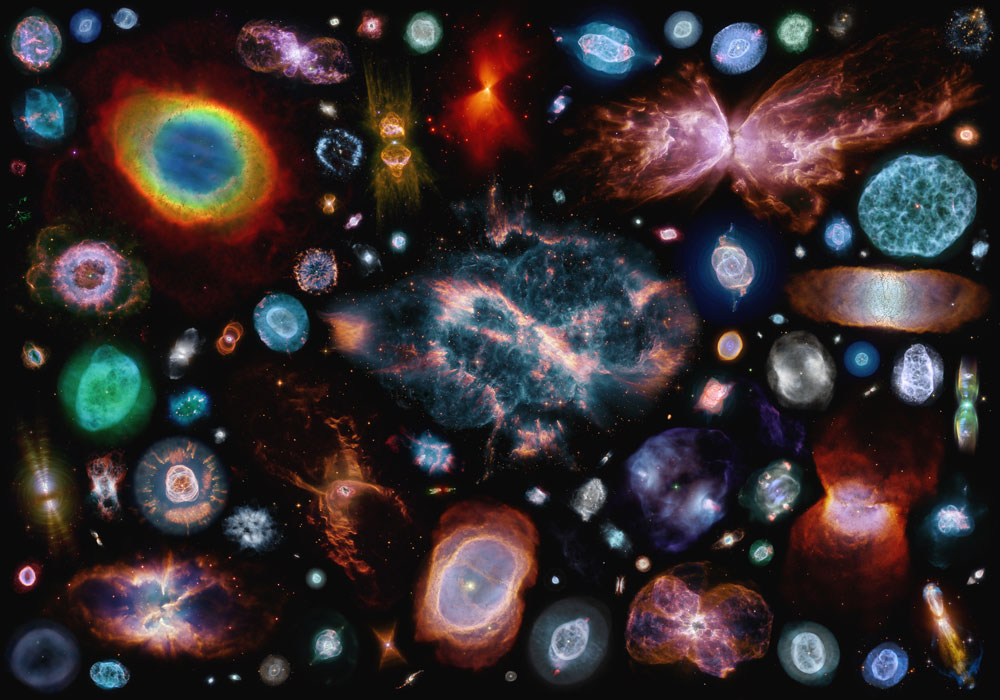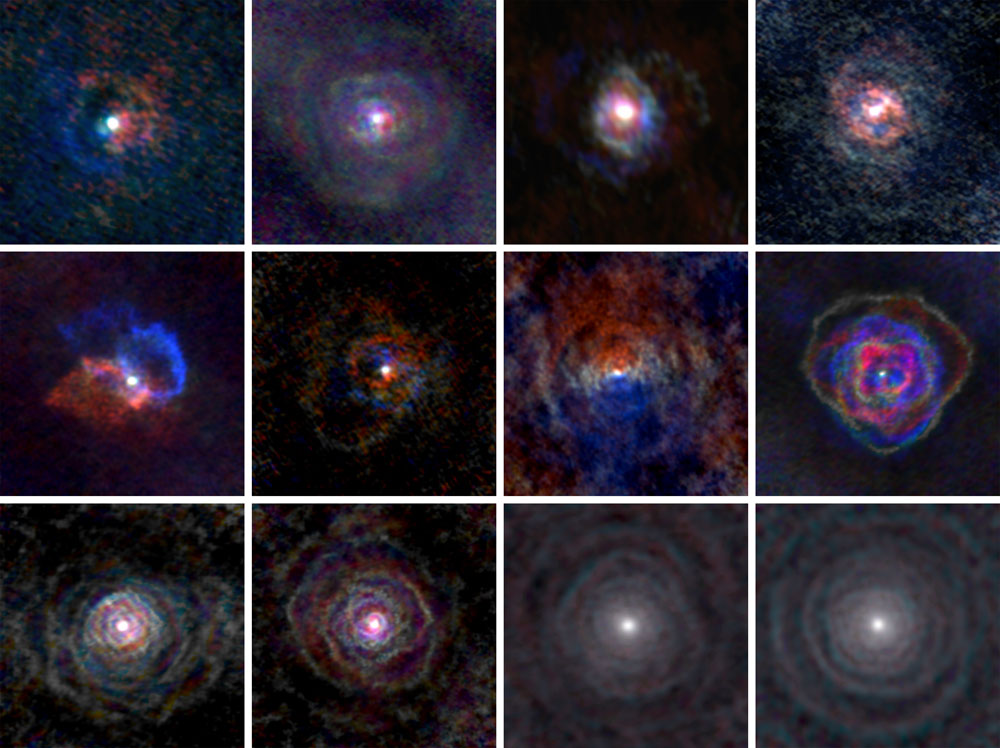New research shows why planetary nebulae range in shape from spirals to butterflies.
Planetary nebulae are like a box of chocolates: You never know what you’re going to get.

Hubble / ESA / NASA; processed by Judy Schmidt CC BY 2.0
The wide variety of shapes and colors these celestial gems display has fascinated observers and theorists alike. These fantastic gas-and-dust eruptions from low-mass stars form shapes such as spirals, roses, butterflies, and even cosmic eyes. Now, a team of observers has looked one step earlier in stellar evolution to explain how these shapes come to be.
One Step Back, Two Steps Forward
Astronomers have long known that planetary nebulae come about in the dying days of less-massive stars — including, one day, the Sun. Such stars shed their outer layers, making the glorious displays we see from Earth, even as the stellar cores collapse into white dwarfs.
But what astronomers have struggled to understand is how the presumably symmetrical winds coming off aging stars make such beautiful asymmetric shapes. Some ideas have included the effects of stellar companions, though more recent research has shown that even giant planets can affect the winds expelled by stars like the Sun.
To understand the evolution of planetary nebulae, Leen Decin (KU Leuven University, Belgium) and colleagues went a step backward in stellar evolution, to asymptotic giant branch (AGB) stars. These cool, red giants can expand to the size of Earth’s orbit, and they shine thousands of times brighter than the Sun. Yet they’re running out of fuel, reduced to fusing carbon in their cores. (Later in their lives, AGB stars can appear as ruby-red carbon stars.)
AGB stars lose up to 0.01% times the Sun’s mass every year, beginning the process of stripping away the stars’ outer layers. But the high rates of mass loss have also obscured what’s happening closer to the star.
The AGB phase is short-lived, and that has also complicated our understanding of the end stages of low-mass stellar evolution. Depending on their individual masses, AGB stars are only 100,000 to 20 million years away from becoming planetary nebulae. The process of making the planetary nebula takes a few thousand years, a blink of the astronomical eye, and the nebula itself only lasts some 20,000 years more before it disperses into interstellar space.
Winds and Companions
Decin’s team studied a sample of 12 AGB stars using the Atacama Large Millimeter/submillimeter Array (ALMA) in Chile. By observing such long wavelengths, ALMA penetrates the gas and dust around these stars to reveal details in their winds — and overturning previous assumptions about their shapes.

L. Decin / ESO / ALMA
None of the 12 AGB stars have symmetric winds, the researchers report in the September 18th Science. All of them have some form of arcs or shells, and some of them even exhibit the kinds of spiral, bipolar, or eye-like shapes that planetary nebulae have.
“Each star, which was only a number before, became an individual by itself,” says coauthor Miguel Montargès (also at KU Leuven). “Now, to us, they have their own identity. This is the magic of having high-precision observations: stars are no longer just points anymore.”
Studies of large populations of stars show that AGB stars, on average, have at least one companion with more than five times Jupiter’s mass. Whether these companions are stars or giant planets, they are likely affecting the evolving shapes of the stellar winds.
The wind’s speed is also key, because as the star loses more mass, the companions’ orbits will widen. Based on the ALMA observations, the researchers develop an equation that predicts whether a star will blow its winds primarily out along its poles — a structure found for stars with weak winds and closeby companions — or whether the wind will take a spiral shape along the equator, found more often for strong winds and farther-out companions.
“This is a wonderful, groundbreaking result in that it makes solid a connection that has been long speculated,” says Morgan MacLeod (Center for Astrophysics, Harvard & Smithsonian), who was not involved in the research. “This result provides a revolutionary degree of evidence for the idea that the multiplicity of stars is key in how evolved stars lose their envelopes.”
The Sun’s Future
What does all this mean for the Sun? One day some 7 billion years from now, it too will become a white dwarf surrounded by a beautiful planetary nebula. Based on their findings, Decin speculates that Jupiter or even Saturn are massive enough to play a role in deciding that nebula’s shape.
“Our calculations now indicate that a weak spiral will form in the stellar wind of the old dying Sun,” she says.
 11
11









Comments
Anthony Barreiro
September 30, 2020 at 7:20 pm
The Hubble gallery image reminds me of looking through a microscope at a drop of pond water.
You must be logged in to post a comment.
Andrew James
October 1, 2020 at 7:32 pm
I read the original article in detail, and I was taken with the quote : "Our results support the claim that binarity may be a prerequisite for the formation of observable aspherical PNe. While magnetic fields and stellar rotation can play a role in shaping PNe (as well as AGB winds), the angular momentum from a binary is thought to be required to sustain the global magnetic field and rotation long enough to affect the geometry of the mass loss and the shaping of the PN."
This is the more significant point.
You must be logged in to post a comment.
Andrew James
October 1, 2020 at 7:34 pm
Morgan MacLeod's quote is slightly overstated IMO. The connection has been known for a decade or two, with several useful papers
Usage of winds here are technically 'superwinds', where as the AGB to PNe transition increase superwind velocity over time
AGB stars mass loss is like puffing train rather than smooth outflow, explaining their 'rose-like' structure
You must be logged in to post a comment.
Andrew James
October 1, 2020 at 7:36 pm
The image shown is in a specific order based on increasing mass loss rate. e.g. S Pav to infra-red IRC +100011
pi Gru has the fast wind twice the others observed
Observations of winds are from CO carbon monoxide
You must be logged in to post a comment.
Roger Venable
October 3, 2020 at 7:28 am
Monica --
Excellent report. My only question is, what is it about the asymptotic giant branch that engendered the label 'asymptotic'? I've read about it for years, but never saw the connection between its location on the Hertsprung-Russell diagram and an asymptote.
You must be logged in to post a comment.
Yaron Sheffer
October 13, 2020 at 10:19 am
This is an excellent question. So I started a search of the astronomical literature. No firm answer yet, but the AGB, which is almost parallel to the more prominent Red Giant Branch, started to show up in HR diagrams in the 50s and 60s, courtesy Arp and Sandage (who both later switched their career directions from stellar evolution to galaxies and cosmology). I think in the 70s they started calling it "asymptotic" because it is getting closer to the RGB as it rises from the horizontal branch, in, well, an aymptotic manner.
You must be logged in to post a comment.
Yaron Sheffer
October 14, 2020 at 8:30 am
Well, let's start by correcting myself: Sandage was into galaxies and cosmology from the start, he did not switch to that field from globular clusters... Next, it does seem that Sandage could be credited with the introduction of the term "asymptotic" in 1966, in a paper together with Walker. See http://articles.adsabs.harvard.edu/pdf/1966ApJ...143..313S
This is confirmed by a research note from Menzies (1967) and by the next Sandage paper in 1968 (co-authored with Katem & Kristian).
You must be logged in to post a comment.
Andrew James
October 16, 2020 at 4:15 am
I've spent on a week trying to post a 4th response here relating to the story. My comment is awaiting moderation but it does not appear. Why?
You must be logged in to post a comment.
Monica YoungPost Author
October 16, 2020 at 10:52 am
It looks like your comment got caught in the spam filter - perhaps because of the link? Although others have commented with links without a problem. In any case, it's approved now.
You must be logged in to post a comment.
Andrew James
October 16, 2020 at 4:19 am
The authors Figure 1 in the paper is perhaps more relevant, as each object is labelled with the scale in AU. e,g. Little 400 AU for S Pav to 10,000-12,000 AU for IRC +10011. A PNe size averages about 60,000 to 100,000 AU across. See arXiv pdf here.
https://arxiv.org/pdf/2009.11694.pdf
You must be logged in to post a comment.
Andrew James
October 16, 2020 at 4:30 am
e,g. Little 400 AU for S Pav to 10,000-12,000 AU for IRC +10011.
You must be logged in to post a comment.
You must be logged in to post a comment.